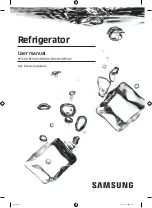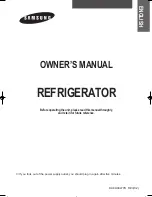
11
STÖRUNGEN
Falls das Gerät Störungen aufweisen sollte,
überprüfen Sie zuerst folgendes:
•
Steckt der Netzstecker in der Steckdose?
•
Befindet sich der Hauptschalter der elektrischen
Anlage in der richtigen Stellung?
•
Ist die Stromzufuhr unterbrochen?
•
Wasserpfütze auf dem Boden des Kühlfaches:
•
Abtauwasserloch verstopft? (siehe Abschnitt
“Abtauen”)
Sollten Sie nach o.e. Prüfungen zu keinem Resultat
kommen, so wenden Sie sich bitte an unseren
nächsten Kundendienst.
Um ein rasches Beheben des Schadens zu
ermöglichen,ist es beim Anruf an den
Kundendienst notwendig,die Modell- und
Seriennummer anzugeben,die Sie dem
Garantieschein oder dem Typenschild (– linke
Seite – unten) entnehmen können.
Achtung:
Benutzen Sie niemals Metallgegenstände,um die
Reifschicht abzukratzen,damit eine
Beschädigungen des Gerätes vermieden werden
kann.
Benutzen Sie kein mechanisches oder anderes
Mittel für einen schnelleren Abtauprozeß mit
Ausnahme der vom Hersteller empfohlenen.
Ein Temperaturanstieg der Tiefkühlkost während
des Abtauens könnte die Aufbewahrungsdauer
verkürzen.
Abtauen
Die sich auf dem Verdampfer des Kühlschrankes
bildende Reifschicht taut jedesmal in den Stillstand-
zeiten des Motorkompressors von selbst ab. Das
Tauwasser läuft durch eine Rinne in eine Plastik-
schale auf der Rückseite des Gerätes (über dem
Kompressor) und verdunstet dort.
Wir empfehlen,das in der Mitte der
Abtauwasserrinne des Kühlraumes befindliche
Ablaufloch für das Abtauwasser regelmäßig zu
reinigen,um zu vermeiden,daß das
Abtauwasser auf die eingelagerten Lebensmittel
tropft. Verwenden Sie den dafür vorgesehenen
Reiniger,der sich schon im Ablaufloch befindet.
Die sich im Gefrierfach bildende Reifschicht soll,
sobald diese eine Stärke von 4 mm erreicht hat, mit
dem mitgelieferten Plastikschaber abgekratzt
werden. Während dieses Vorganges ist es nicht
nötig, das Gerät auszuschalten und die
Nahrungsmittel herauszunehmen.
Wenn sich jedoch eine dicke Eisschicht bildet, muß
man vollkommen abtauen. Um ein vollständiges
Abtauen durchzuführen, geht man wie folgt vor:
1. Ein/Aus Schalter drücken.
2. Die Tür offen lassenund den Plastikschaber, der
als Rinne dient, am vorgesehenen Platz einsetz-
en, sodaß das Abtauwasser in ein geeignetes,
darunter gestelltes Gefäß fließen kann.
3. Nach beendetem Abtauprozeß das Gefrierteil gut
nachtrocknen. Plastikschraber für späteren
Gebrauch aufbewahren.
4. Ein/Aus Schalter drücken
5. Nachdem das Gerät für 2-3 Std. in Betrieb
genommen wurde, können tiefgefrorene
Lebensmittel darin zurückgelegt
D037
D068
14
CONTENTS
Warnings . . . . . . . . . . . . . . . . . . . . . . . . . . . . . . . . . . . . . . . . . . . . . . . . . . . . . . . . . . . . . . . . . . . . . . . . . . .
13
Use -
Cleaning the interior - Control Panel . . . . . . . . . . . . . . . . . . . . . . . . . . . . . . . . . . . . . . . . . . . . . . . . . . . . .15
Use -
Operation - Movable shelves - Moistur regulator - Bottle holder . . . . . . . . . . . . . . . . . . . . . . . . . . . . . . .
Fresh food refrigeration . . . . . . . . . . . . . . . . . . . . . . . . . . . . . . . . . . . . . . . . . . . . . . . . . . . . . . . . . . . . . . . . . . . .16
Use
- Positioning the door shelves
-
Control Panel . . . . . . . . . . . . . . . . . . . . . . . . . . . . . . . . . . . . . . . . . . . . . .17
Use
- Operation - Freezing fresh food
-
Storage of frozen food - Cold accumulator - Thawing - Ice-cube
production . . . . . . . . . . . . . . . . . . . . . . . . . . . . . . . . . . . . . . . . . . . . . . . . . . . . . . . . . . . . . . . . . . . . . . . . . . . . . . .18
Hints -
Hints for refrigeration - Hints for freezing - Hints for storage of frozen food . . . . . . . . . . . . . . . . . . . . .19
Maintenance -
Periods of no operation - Periodic cleaning - Interior light - Defrosting . . . . . . . . . . . . . . . . .20
Customer service and spare parts - Installation -
Location - Electrical connection . . . . . . . . . . . . . . . . .21
Installation -
Dimensions of housing . . . . . . . . . . . . . . . . . . . . . . . . . . . . . . . . . . . . . . . . . . . . . . . . . . . . . .22
•
Do not place carbonated or fizzy drinks in the
freezer as it creates pressure on the container,
which may cause it to explode, resulting in
damage to the appliance. Do not use a
mechanical device or any artificial means to
speed up the thawing process other than those
recommended by the manufacturer. Never use
metal objects for cleaning your appliance as it
may get damaged.
Installation
• During normal operation, the condenser and
compressor at the back of the appliance heat up
considerably. For safety reasons, minimum
ventilation must be as shown in the instructions.
Attention: keep ventilation openings clear of
obstruction.
• Care must be taken to ensure that the appliance
does not stand on the electrical supply cable.
Important:
if the supply cord is damaged, it must
be replaced by a special cord or assembly availa-
ble from the manufacturer or its service agent.
• If the appliance is transported horizontally, it is
possible that the oil contained in the compressor
flows in the refrigerant circuit. It is advisable to
wait at least two hours before connecting the
appliance to allow the oil to flow back in the
compressor.
• There are working parts in this product which
heat up. Always ensure that there is adequate
ventilation as a failure to do this will result in
component failure and possible food loss. See
installation instructions.
• Parts which heat up should not be exposed.
Wherever possible the back of the product should
be against a wall.
Environment Protection
This appliance does not contain gasses which
could damage the ozone layer,in either its
refrigerant circuit or insulation materials. The
appliance shall not be discarded together with
the urban refuse and rubbish. Avoid damaging
the cooling unit,especially at the rear near the
heat exchanger. Information on your local
disposal sites may be obtained from municipal
authorities. The materials used on this appliance
marked by the symbol
are recyclable.






























